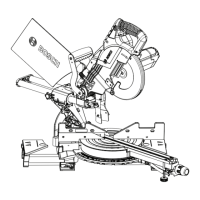42
Auxiliary fence
MAKING AN AUXILIARY FENCE:
Certain types of molding need a fence face
e
xtension because of the size and position of the
workpiece. Holes are provided in the fence to
attach an auxiliary fence. The auxiliary fence is
used with the saw in the 0° bevel position only.
1. Use ¾” thick piece of wood (plywood is prefferd)
to cut an auxiliary fence based on dimensions
shown in Figure 49.
2. Place the auxiliary fence against the miter saw
fence (figure 48). Check that auxiliary fence does
not interfere with head assembly. Check for
interference between the auxiliary fence and the
lower blade guard. Make adjustments as
necessary.
Check for interference
between auxiliary fence and
saw head componenents by performing a dry run.
Fence interference can prevent proper saw
operation and cause injury and/or tool damage.
3. Mark the locations of the support holes on the
wood from the back side of the fence (figure 48).
4. Drill and countersink the holes on the front of the
support board.
To fasten from front of fence:
1. Attach auxiliary fence using four (4) 3/16" x 1-
1/2" long flat head machine bolts. Secure behind
metal fence with washer and #5 machine nuts.
Be aware of the path of the
saw blade. Make a dry run
with the saw Off by conducting a simulated
cutting cycle, and observe the projected path of
the saw blade. Keep hands at least six (6) inches
away from the projected path of the saw blade.
2. Make a full depth cut to create the blade slot.
To fasten from back of fence:
Use minimum 3/4" thick auxiliary fence and 1/4"
round head wood screws (3/4" long).
1. Drill four pilot holes through auxiliary fence and
run screws from rear of metal fence.
Be aware of the path of the
saw blade. Make a dry run
with the saw Off by conducting a simulated
cutting cycle, and observe the projected path of
the saw blade. Keep hands at least six (6) inches
away from the projected path of the saw blade.
2. Make a full depth cut to create the blade slot.
Flat Head Machine
Screws
Auxiliary
Fence
Blade
Slot

